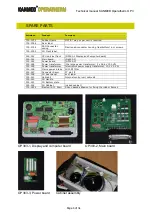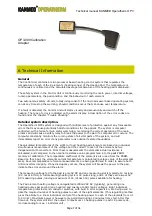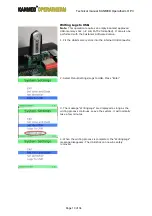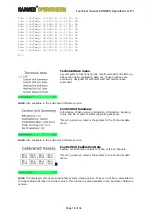
Technical manual
KANMED Operatherm OP3
Page
4
of
34
3 SAFETY INFORMATION
Please refer to the safety information found in the User Manual for hazards related to
normal operation of the system.
Warnings
•
System Malfunction.
If the Operatherm OP3 self test does not perform correctly or the function
supervision has displayed an alarm or error message or the Control Unit has received mechanical damage,
it must be examined by a qualified technician before being used. If the Operatherm OP3 is suspected to not
operating properly, immediately consult a qualified technician for advice.
•
Electrical Hazard
The system must always be connected to a mains power outlet with proper protective
grounding. Always remove the mains power cable before cleaning the Control Unit.
NOTE
: The OP3 may
not be interfaced with any other electrical system. If this is done a new “system” is created per definition,
and the safety classification of the OP3 may be effected.
•
Dropped or otherwise possibly damaged.
If the Operatherm OP3 Control Unit had fallen to the floor or
has been subjected to other possible damage it must be examined by a technician before being used.
•
Always remove mains power when the control unit is opened!
•
Always perform internal work with the system in an ESD-protected environment.
Caution
•
Modifications.
Un-authorised personnel are not allowed to open the Control Unit or the Heating Pad
Connector. No modifications of the system, of any kind, are allowed since it will void the safety certification
of the system and may seriously endanger patient safety. Only original parts may be used. The Heating
Pad cable may not be altered in length or repaired in any way. If damaged, the complete Heating Pad must
be replaced.
•
Compatibility.
Only KANMED OP3 series Heating Pads can be used with Operatherm OP3 Control Unit. The
Operatherm OP3 system is NOT compatible with KANMED OP200 series Heating Pads.
•
EMC.
Operatherm OP3 needs to be installed and put into service according to the EMC information
provided. (Detailed EMC information can be downloaded from
www.Kanmed.se
)
•
DIATHERMY equipment and Defibrillators.
Under normal circumstances the Operatherm OP3 is not
disturbed by this type of equipment. However, if the diathermy or defibrillation is set at very high output
levels, the Operatherm OP3 might go into alarm state. In such a case, restart the system and observe that
the self test is being performed correctly. Note that the Control Unit housing is electrically connected to
earth.
•
ECG disturbance.
Under unfavourable conditions there is a risk that interference may occur on ECG
traces. This may occur if the ECG electrodes are not being applied strictly to the manufactures instructions
or if the Operatherm OP3 Heating Pad is positioned upside down (text side facing down).
•
MRI cameras.
The system is not designed for use with MRI cameras.
•
Heating Pad storage.
The Heating Pad should be stored using the Pad Hanger for wall mount that is
included in all control unit deliveries or rolled to a diameter not less than 150mm. Do not bend or fold the
Heating Pad in a way that sharp crease arises.
•
Cleaning
. Users should not use cleaning or decontamination methods different from those recommended
by Kanmed without first checking with Kanmed that the proposed methods will not damage the equipment.





































